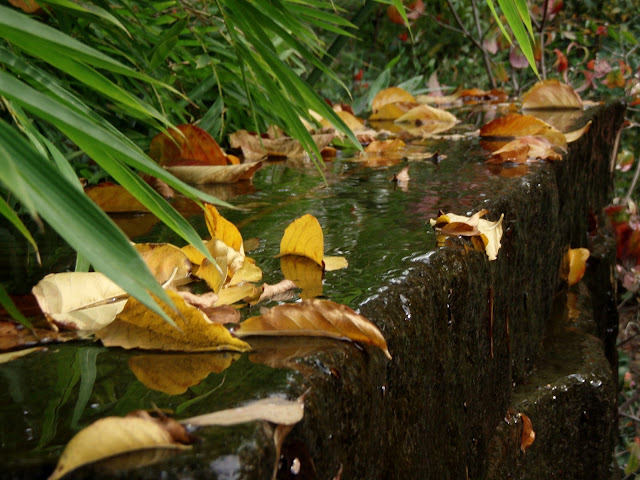Plan to visit areas that are shady and cool! We have compiled a list of the 7 coolest places in the Arboretum so that you don’t have to wait for cooler weather to visit. So here are the 7 coolest places in the Arboretum, from furthest to closest:
1. Meyberg Falls
2. The Historic Section
3. The Bamboo Grove
4. The Tropical Rainforest
5. The Tropical Greenhouse
6. The Celebration Garden
7. The Arboretum Library
Let’s take a look.
 |
| Meyberg Falls |
Meyberg Falls
On just about any day here at the Arboretum you can find a dozen or more people hanging out here. Besides visitors, it’s popular with wedding photographers, music video producers and feature film makers. Katy Perry’s ‘Roar’ Video, Beyonce’s ‘Survivor’ video and the Rock video scene in “Wayne’s World” were just some of the many that were filmed there. |
| Lucky Baldwin's Queen Anne Cottage |
The Historic Section
When San Francisco hotelier and millionaire Lucky Baldwin decided to invest in property here in the L.A. area, the Santa Anita ranch was one of the first purchases he made. Lucky’s ranch was surrounded by dry communities, so alcohol, gaming and horse racing were regular activities. To raise his ranch’s status above that of a mere roadhouse he featured fine varietal wines, a first class hotel, and to attract a higher class of clientele, authors, actors, opera singers and other celebrities of the day as featured guests. These celebs would stay at Lucky’s Queen Anne Cottage and give lectures, recitals and concerts to attract the staid citizens of the surrounding towns.This historic section of the Arboretum is planted with many large trees, many over 100 years old, that provide shade -and a large lawn that is popular with weddings and other events.
 |
| Shady path through a bamboo grove here. |
The Bamboo Grove
The Arboretum has many exemplary collections, including over 60 different species of bamboo. Some of these bamboo, like Phyllostachys aurea, have formed dense and shady groves where you can duck in and avoid the sun in a cool, green forests of the grassy plants. The interiors of these groves can resemble green caverns and they are very popular with videographers, photographers and artists. A word of warning; be careful of the many small, stake-like stumps that can pose a tripping hazard. |
| The Tropical Rainforest |
The Tropical Rainforest
Situated on the North side of Baldwin lake, the Tropical Rainforest is an area that represents the forests of the tropics and subtropics. Situated under tall Cypress trees from the American South and Mexico, this shaded paradise contains a collection of cycads, a grove of bamboo, and a disparate collection of tropical trees from around the world. There are several benches located in the forest, making it the perfect place to sit down and relax. |
| Inside the Tropical Greenhouse |
The Tropical Greenhouse
When the weather is boiling hot the Tropical Greenhouse, located to the North of the main entrance, is not. That’s because it is usually kept to a constant temperature somewhere around 85 degrees -a relative ice box when the temperature is hovering around 105. Inside are orchids, ferns, bromeliads and even a Cocoa tree, the source of chocolate.
 |
| Small courtyard fountain in the Demonstration Garden. |
 |
| Top of the Weeping Fountain in Lew Watanabe's meditation garden vignette in the Demonstration Garden. |
The Celebration Garden
This area is a cool collection of shaded ‘vignette’ gardens that used to make up the Sunset demonstration garden, an area originally envisioned in the envisioned as being a demonstration and an inspiration to do-it-yourself landscapers. It’s last refurbishing, back in 1998, featured vignettes from cutting edge landscape architects and designers. Still visible today are a shady lawn garden, a courtyard fountain garden, a low water use deck area that uses synthetic recycled deck elements, a California native garden that uses polished granite as a faux stream, a shaded walk among California coastal redwoods and Canary Island pines, and finally a traditional Japanese meditation garden fashioned by the late Sierra Madre garden designer Lew Watanabe. Lew’s garden contains an example of his signature ‘weeping wall’ fountains, granite sculptures that are painstakingly made level so that the water pumped out the top covers the top and side of the fountain with a thin film of flowing water. |
| The Arboretum Horticultural Library |
The Arboretum Horticultural Library
One of the finest collections of horticultural and botanical texts on the west coast, it is also a fine example of mid-century modern architecture.A recent remodel has rendered its interior space true to its mid-century roots. Come inside and see the newly revealed vaulted ceiling, true-to-period lamps and furniture and spacious, yet less claustrophobic book shelving. Say 'Hi' to myself and librarian Susan Eubank. And, most importantly, enjoy the massively effective air conditioning.




















